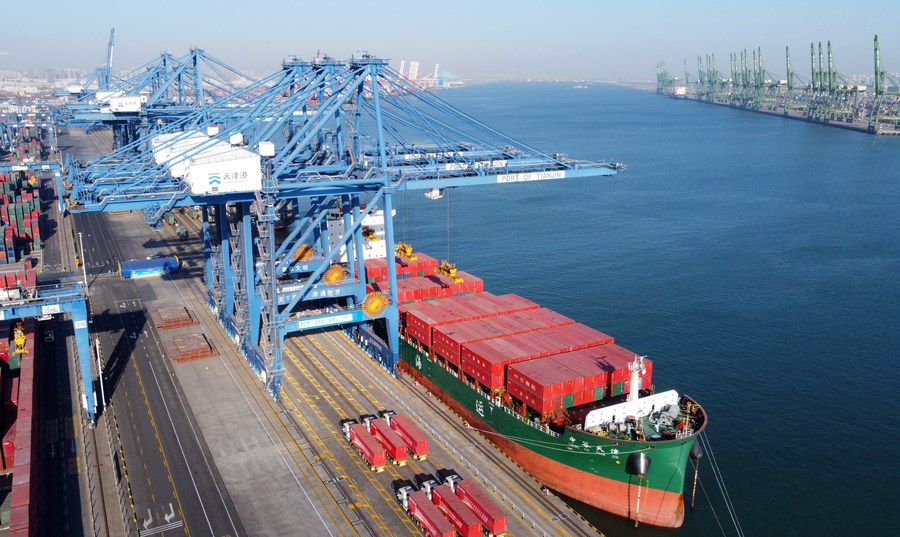BRI helps ties with Latin America thrive

A smart container terminal at Tianjin Port in North China's Tianjin on Jan 17, 2021. [Photo/Xinhua]
Ties between Latin America and China have moved from strength to strength with Belt and Road Initiative expansion as people on both sides make stronger connections and increase exchanges.
Between 2002 and 2021, trade between the world's second-largest economy and Latin America soared from $18 billion to $450 billion.
"It is a particularly good moment for China's relations with Latin America. The COVID-19 pandemic is now a bit more under control, trade is happening extremely fast and in a very dynamic fashion, despite difficulties such as global freight rates," said Henrique Reis in Sao Paulo, Brazil. Reis is international relations manager at the China Trade Center Group, which promotes the development and enhancement of trade, technological and cultural cooperation between China and Brazil.
Brazil is one of the countries in the region whose trade performance with China is hitting new highs and bringing in more cultural exchanges.
"China and Brazil had a new trade record last year, reaching over $135 billion," said Reis. Exports to China rose 29.4 percent to over $87 billion. About 31 percent of Brazilian exports were shipped to China, which is Brazil's main trade partner.
Neighboring Argentina is also strengthening ties with China. President Alberto Fernandez traveled to Beijing this year, for the opening of the Winter Olympic Games and to mark his country's official joining of the China-led Belt and Road Initiative.
"The incorporation of Argentina into the BRI is a milestone. Argentina faces a historic opportunity to expand the lines of cooperation and trade with China," said Vicente Teruggi, director of projects at the Sino-Argentine Observatory, a nonprofit organization in Buenos Aires.
Teruggi said this is not limited "to cooperation, financing and trade, but also enables Argentina to bring its technology, knowledge and value-added products to the entire BRI bloc".
Trade between China and Argentina in 2021 totaled $19.6 billion, with Argentina exports of over $6.1 billion, up around 17 percent year-on-year. In December 2021, Argentina exported more than 36,000 tons of meat to China, three times as much as in January 2018, according to Delta Analysis, an analytics firm with operations in Buenos Aires.
With its entry into the BRI, Argentina now has one of the most important challenges of the last 20 years, said Teruggi. "It is an opportunity to seize in a strategic and planned way and one that requires a lot of patience."
Up in the Andean region, Peru's trade with China is also increasing at a fast pace. Coffee exports from Peru to China more than tripled between 2018 and 2021 to over $1.4 billion. Opportunities are also on the rise for native products such as quinoa, an Andean cereal.
According to the Peruvian government, trade between Peru and the Chinese mainland in 2021 rose 39 percent, reaching almost $31 billion, in great part supported by mineral and fishing products. Meanwhile, trade with the Hong Kong Special Administrative Region rose 72 percent.
"China was the export destination for Peru in 2021, in great part due to raw materials and agro-industrial products," said Ramon Abasolo, a political analyst in Lima.
David Castrillon, research professor in international relations at the Externado University of Colombia, said: "The economic relationship between Latin America and China is entering a new stage that promises greater development for the region."
Colombia is also a country increasing its economic exchange with China and, like others such as Uruguay, aims to sign a free trade agreement with China by the end of the year.
Free trade agreements and the BRI are helping Latin America and China integrate in a more profound way.
"What was a strictly commercial relationship has now broadened and deepened to new areas, for example, the export of consumer goods and services, the financing and participation in construction projects, and the financing of both State-owned and private sector companies," said Castrillon.
Peru's former foreign minister Oscar Maurtua said China has great significance in the region and that the BRI is key for China to meet its international goals.
"During the 19th century, power predominated in the Mediterranean, during the 20th century in the Atlantic, and the 21st century in the Pacific; and China has a transcendent role," said Maurtua.
"China has asserted itself in Latin America in the face of the disdainful attitude of the previous US administration, between 2017 and 2020," he said, adding that the BRI "projects it (China) globally".
The author is a freelance journalist for China Daily.
























